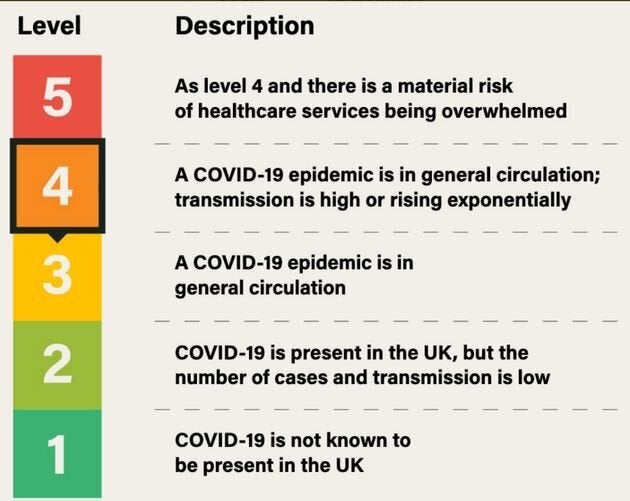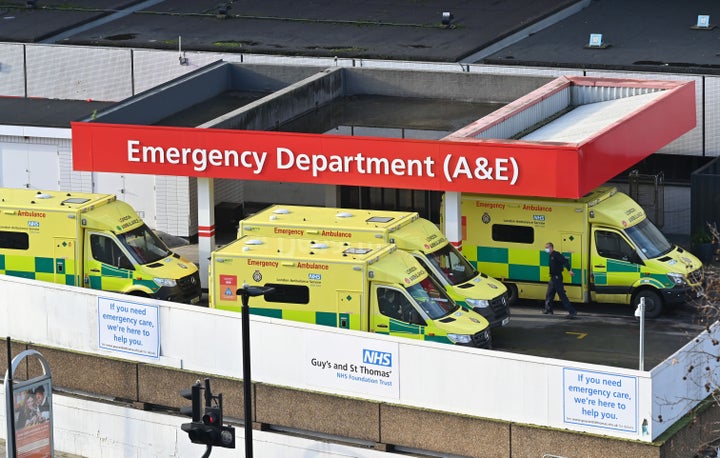The UK’s coronavirus alert level will be raised to the highest possible setting, the government has confirmed.
The Covid-19 alert level has risen from level four to level five, following a joint statement by the chief medical officers for England, Scotland, Wales and Northern Ireland, and NHS England’s national medical director Professor Stephen Powis.
Level five means “there is a material risk of healthcare services being overwhelmed”, the virus is in general circulation, and transmission is high or rising exponentially.
It is the first time the alert level has ever risen to the highest setting.
First unveiled in May, Boris Johnson said the level is determined by the reproduction rate of Covid-19 known as the “R number” – the average number of people each infected person transmits the virus to – and the number of confirmed cases.
Set up by the Joint Biosecurity Centre, which includes the chief medical officers of the four UK nations, the colour-coded alert system is separate from the tier restrictions system.
In England, the government has set out five specific tests to determine lockdown measures. The alert level system is set by scientists and is used as a guide to all four nations rather than a mandate to certain action.
In September, Britain’s coronavirus alert level was ramped up from level three, which states that a Covid-19 epidemic is in general circulation, to level four, when transmission of the virus is high or rising at an ever-increasing rate.

Level three is when the epidemic is in general circulation and a gradual easing of restrictions can take place.
Level two is when the number of cases and transmission is low and “no or minimal” restrictions are required.
Level one means coronavirus is no longer known to be in the UK.
In a joint statement on Monday evening, the chief medical officers for England, Scotland, Wales and Northern Ireland, and NHS England’s national medical director Professor Stephen Powis said that due to rising cases and without further action there is a risk of the NHS “in several areas” being overwhelmed over the next 21 days.
They said: “Following advice from the Joint Biosecurity Centre and in the light of the most recent data, the four UK chief medical officers and NHS England medical director recommend that the UK alert level should move from Level 4 to Level 5.
“Many parts of the health systems in the four nations are already under immense pressure. There are currently very high rates of community transmission, with substantial numbers of Covid patients in hospitals and in intensive care.
“Cases are rising almost everywhere, in much of the country driven by the new more transmissible variant. We are not confident that the NHS can handle a further sustained rise in cases and without further action there is a material risk of the NHS in several areas being overwhelmed over the next 21 days.
“Although the NHS is under immense pressure, significant changes have been made so people can still receive lifesaving treatment. It is absolutely critical that people still come forward for emergency care. If you require non-urgent medical attention, please contact your GP or call NHS 111.”
The news comes ahead of Johnson’s TV address at 8pm on Monday, after the prime minister warned there were “tough, tough” weeks to come amid a surge in infections.
Latest figures show the UK has recorded its highest ever total 58,784 coronavirus cases in 24 hours, while 407 more deaths have been linked to Covid.
Some 75,431 people in the UK have now died within a month of testing positive for Covid-19, and 2,713,563 have tested positive since the pandemic hit in March.
A No.10 spokesperson said: “The prime minister is clear that further steps must now be taken to arrest this rise and to protect the NHS and save lives. He will set those out this evening.”


